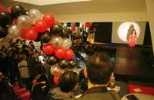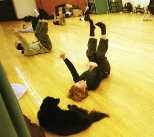Fashion show charms the crowd
The eighth iteration of MIT's Charm School (now the Stratton School for Charm) culminated in the first annual Charm School fashion show, held in the lobby of the Student Center on February 2. A graduation ceremony and a performance by the Chorallaries completed the day-long curriculum in social skills.
The fashion show was an immediate hit. The Dance Mix Coalition provided a pounding backbeat as a dozen student models displayed affordable outfits for job interviews, casual business wear, and semiformal and formal social events. School for Charm students, fans of the models and passersby crowded the lobby as emcees Kelley Norman of Career Services and Kyle Ives from Men's Warehouse commented on each style as models strolled the T-shaped runway. Tuxedos and evening wear drew whistling and applause.
"It went exceptionally well. The models were absolutely wonderful and our corporate sponsors could not have been more helpful," said Deborah Liverman, assistant director of Career Services and producer of the fashion show. Ms. Liverman, who had been in fashion shows herself but had never produced one, began working on this show last October with the five-member Fashion Show committee consisting of Career Services staff.
Larry Benedict, dean for student life, was resplendent in full tuxedo for his role as headmaster of Charm School. Commenting on the graduation, he said, "I thought of all the bores and yahoos I had known over the years, and the advice I've got to pass on to the Charm School graduates is this: Be the most enthusiastic person you know. Be the first to smile and say hello. Remember people's names. Don't whine. Don't chew gum in public. Don't slurp your soup. And don't eat the last brownie on the plate!"
Katie O'Dair, assistant dean for student life programs, estimated that 900 MIT students participated in two dozen School for Charm courses this year.
Dean Benedict conferred 79 PhD degrees, 67 master's degrees and 50 bachelor's degrees in charm. He introduced Mrs. Julius Stratton to the appreciative group and joined in applauding the Chorallaries, who entered the lobby playing kazoos. They sang, among other favorites, the new Charm School song, which had lyrics such as, "We'll stride with manners flag unfurled."
Sarah H. Wright
Nuclear power: an idea whose time has come again?
Increasing demands for energy coupled with other factors such as heightened awareness of fossil fuels' contributions to global warming have resulted in a renewed interest in nuclear energy, said Professor of Nuclear Engineering Mujid Kazimi at a January 29 IAP talk.
Nuclear energy "is again considered a good choice rather than a last choice," he said in the first of seven IAP talks on "Energy in a Sustainable World." The series is sponsored by the Center for Advanced Nuclear Energy Systems, which Professor Kazimi directs.
During his presentation, he touched on the current state of the industry, while also describing future directions in nuclear technology. He noted, for example, that even with no new nuclear plants, the share of electricity from existing plants in the United States has actually grown slightly over the last 10 years. "We can derive much more power from those plants," he said.
Challenges for next-generation reactors include the reduction of construction and operating costs. "The need to compete with inexpensive gas-fired plants implies a reduction of [reactor construction] costs by about 20 percent," Professor Kazimi said. Other challenges include making safety transparent (reducing the number of engineering systems necessary to maintain safety) and reducing the waste burden.
MIT researchers are involved in research toward several innovative US reactor technologies. These include the pebble-bed reactor, in which microscopic fuel particles are placed in graphite "pebbles" the size of tennis balls.
After the talk, people who identified themselves as being in the field nevertheless asked about negative public perceptions of nuclear energy. For example, "How do we deal with the issue of getting sites for newer, safer, more economical plants?"
Professor Kazimi replied that "it's not clear to me that this is unique to nuclear." Other kinds of power plants have the same problems with siting. "Unless we can deal with this as a society we will see repercussions, as we're seeing in California."
Elizabeth Thomson
LEGO robots battle it out in annual 6.270 contest
Sixty teams of three members each fought for victory in the annual LEGO-based 6.270 robot design competition, an elimination tournament that spanned two days and one evening of the final week of IAP.
"Don't Worry," a machine made by seniors Brian Lin and Fred S. Lee, won the four-hour-long final round.
Despite dire warnings in the IAP catalogue (the course runs at "ludicrous speed," it says) and countless frustrations with the teeny-weeny toy bricks and the various sensors that drive them, students vie to participate, making 6.270 oversubscribed every year.
This year's competition produced several instant crowd-pleasers and some very impressive poster art. The object of the game was to gather heavy gold rubber balls into one's court.
The crowd-pleasing machines had ominous names ("The Sultan of Swat," "Murphy's Plow of Doom," "Spiky Wall of Terror"); they employed surprise attacks, usually with sudden eruptions of arm-like devices, and sometimes won their rounds. Most successful were the machines like "Wapos" that had ramps that flapped open on a slant and relied on gravity to escort the big gold balls into the right court. One machine, "Zekrit Ninja Phatapult," seemed to swallow and then spit out the gold ball.
Each team not only designed and built a LEGO masterpiece, but also created a poster about it. Among these posters, "Murphy's Plow of Doom" and "MiniMax" were suitable for framing.
Halftime entertainment was provided by LEGO League Robotics Champions from the Lunenberg Middle School. They wore orange T-shirts and bravely spoke about their robot to the restless, enthusiastic crowd in Rm 26-100.
Sarah H. Wright
A version of this article appeared in MIT Tech Talk on February 7, 2001.








